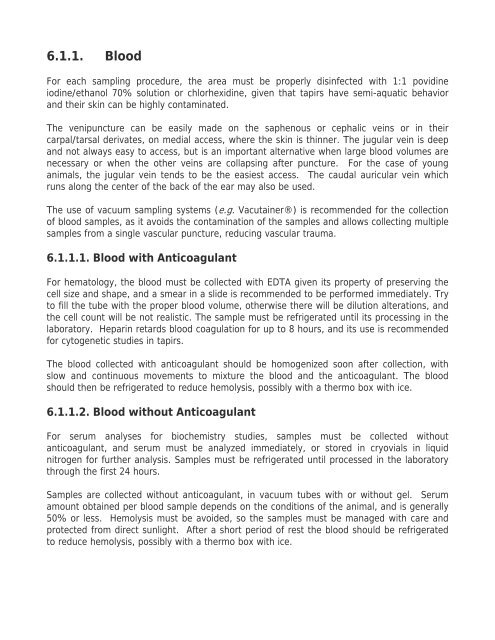TAPIR FIELD VETERINARY MANUAL - Tapir Specialist Group
TAPIR FIELD VETERINARY MANUAL - Tapir Specialist Group
TAPIR FIELD VETERINARY MANUAL - Tapir Specialist Group
Create successful ePaper yourself
Turn your PDF publications into a flip-book with our unique Google optimized e-Paper software.
6.1.1. Blood<br />
For each sampling procedure, the area must be properly disinfected with 1:1 povidine<br />
iodine/ethanol 70% solution or chlorhexidine, given that tapirs have semi-aquatic behavior<br />
and their skin can be highly contaminated.<br />
The venipuncture can be easily made on the saphenous or cephalic veins or in their<br />
carpal/tarsal derivates, on medial access, where the skin is thinner. The jugular vein is deep<br />
and not always easy to access, but is an important alternative when large blood volumes are<br />
necessary or when the other veins are collapsing after puncture. For the case of young<br />
animals, the jugular vein tends to be the easiest access. The caudal auricular vein which<br />
runs along the center of the back of the ear may also be used.<br />
The use of vacuum sampling systems (e.g. Vacutainer®) is recommended for the collection<br />
of blood samples, as it avoids the contamination of the samples and allows collecting multiple<br />
samples from a single vascular puncture, reducing vascular trauma.<br />
6.1.1.1. Blood with Anticoagulant<br />
For hematology, the blood must be collected with EDTA given its property of preserving the<br />
cell size and shape, and a smear in a slide is recommended to be performed immediately. Try<br />
to fill the tube with the proper blood volume, otherwise there will be dilution alterations, and<br />
the cell count will be not realistic. The sample must be refrigerated until its processing in the<br />
laboratory. Heparin retards blood coagulation for up to 8 hours, and its use is recommended<br />
for cytogenetic studies in tapirs.<br />
The blood collected with anticoagulant should be homogenized soon after collection, with<br />
slow and continuous movements to mixture the blood and the anticoagulant. The blood<br />
should then be refrigerated to reduce hemolysis, possibly with a thermo box with ice.<br />
6.1.1.2. Blood without Anticoagulant<br />
For serum analyses for biochemistry studies, samples must be collected without<br />
anticoagulant, and serum must be analyzed immediately, or stored in cryovials in liquid<br />
nitrogen for further analysis. Samples must be refrigerated until processed in the laboratory<br />
through the first 24 hours.<br />
Samples are collected without anticoagulant, in vacuum tubes with or without gel. Serum<br />
amount obtained per blood sample depends on the conditions of the animal, and is generally<br />
50% or less. Hemolysis must be avoided, so the samples must be managed with care and<br />
protected from direct sunlight. After a short period of rest the blood should be refrigerated<br />
to reduce hemolysis, possibly with a thermo box with ice.










